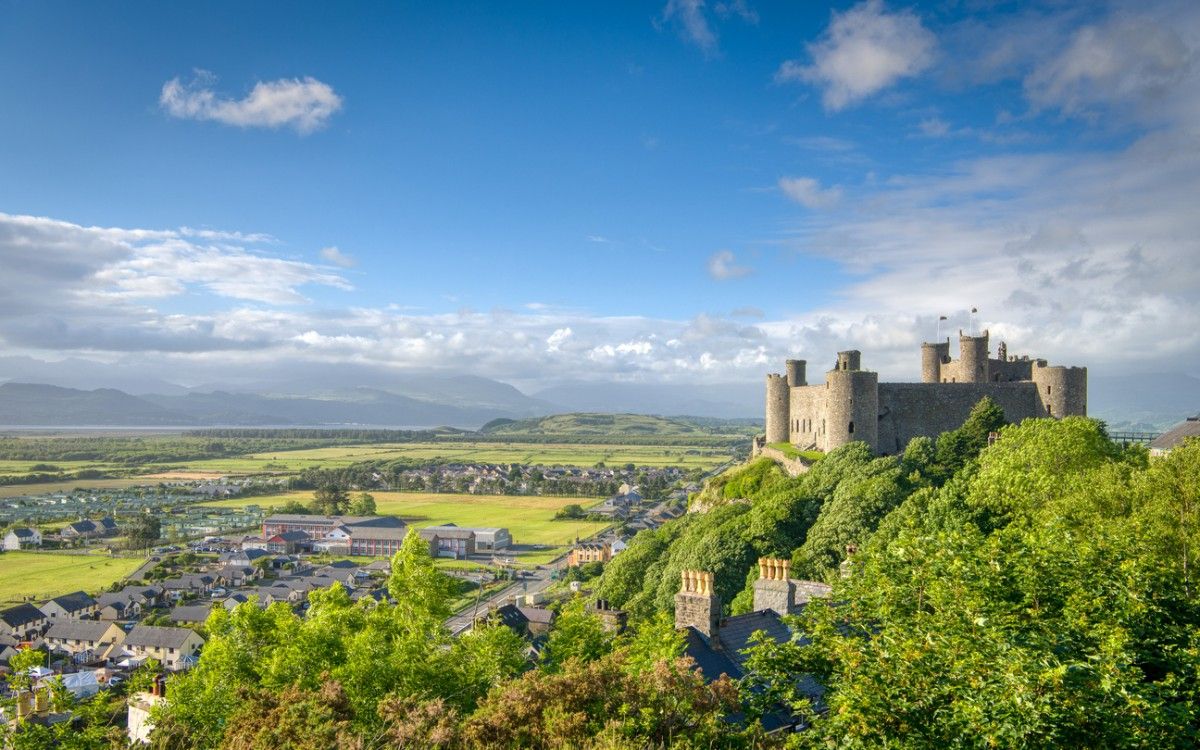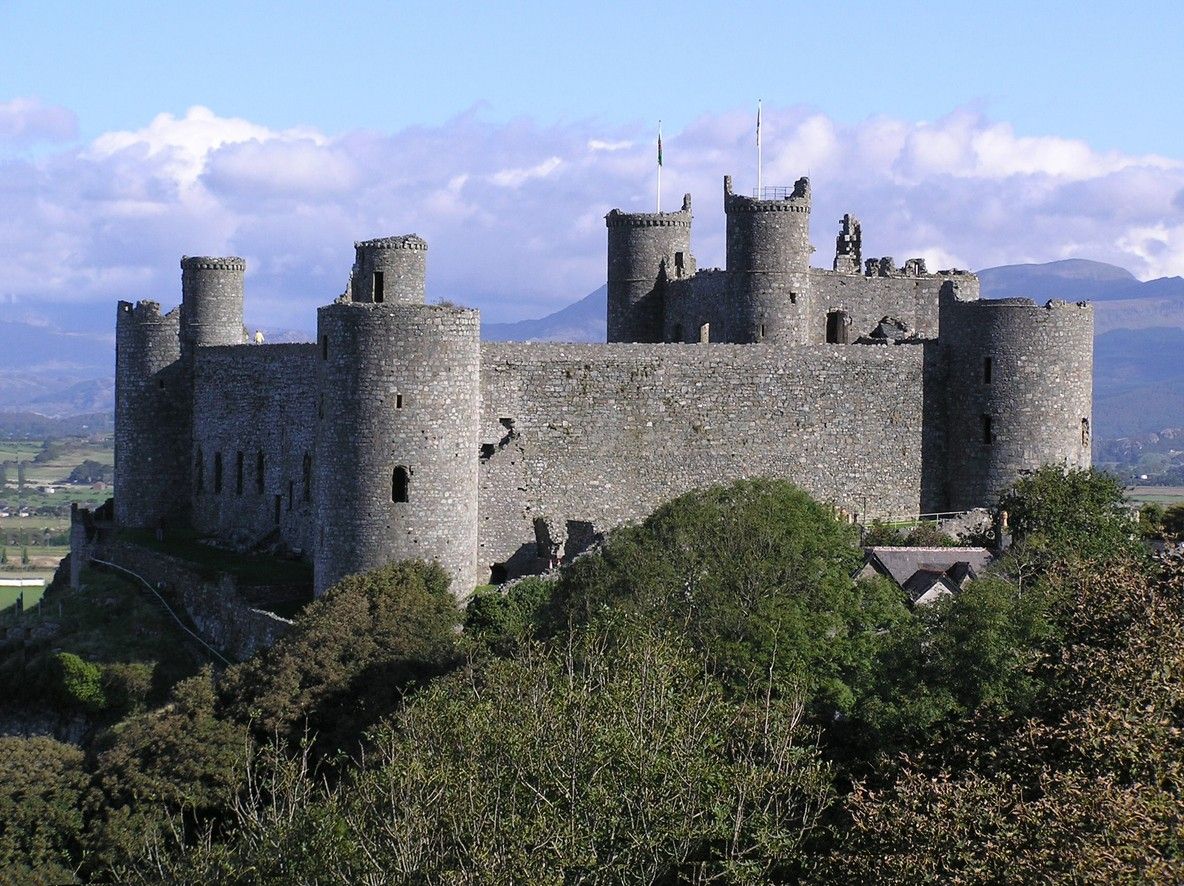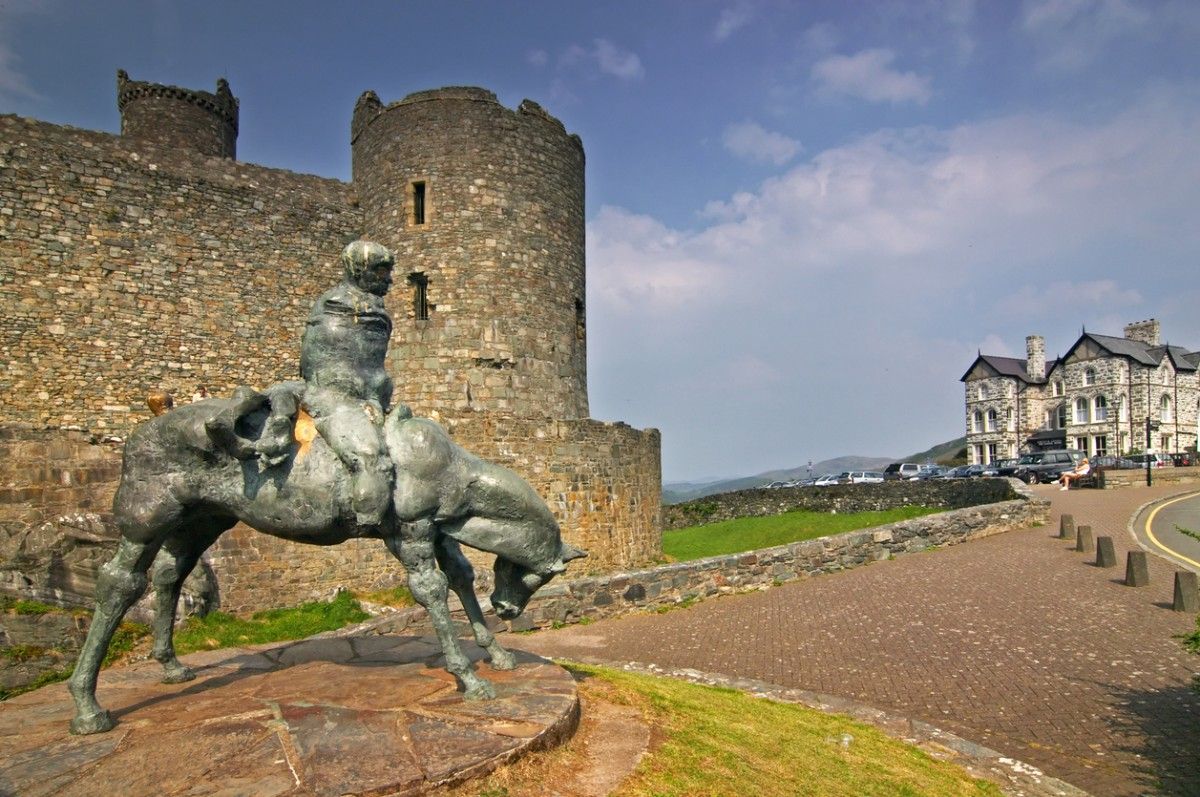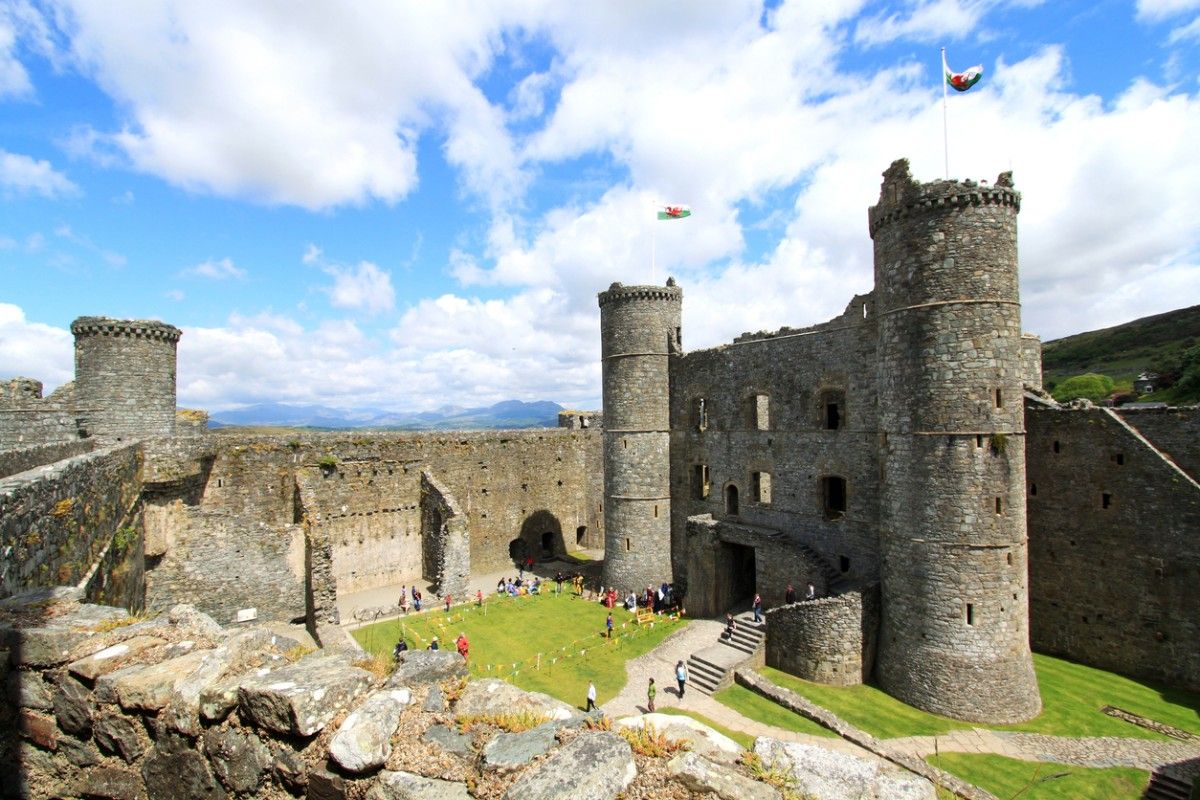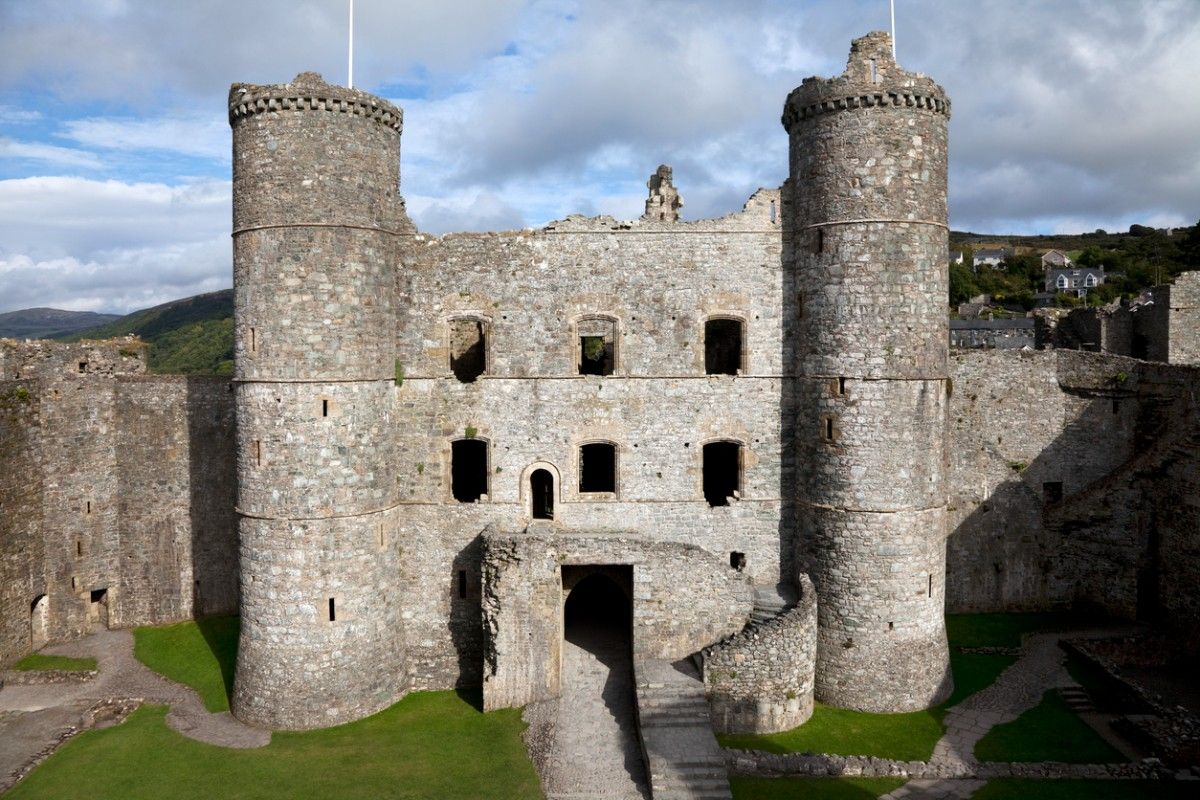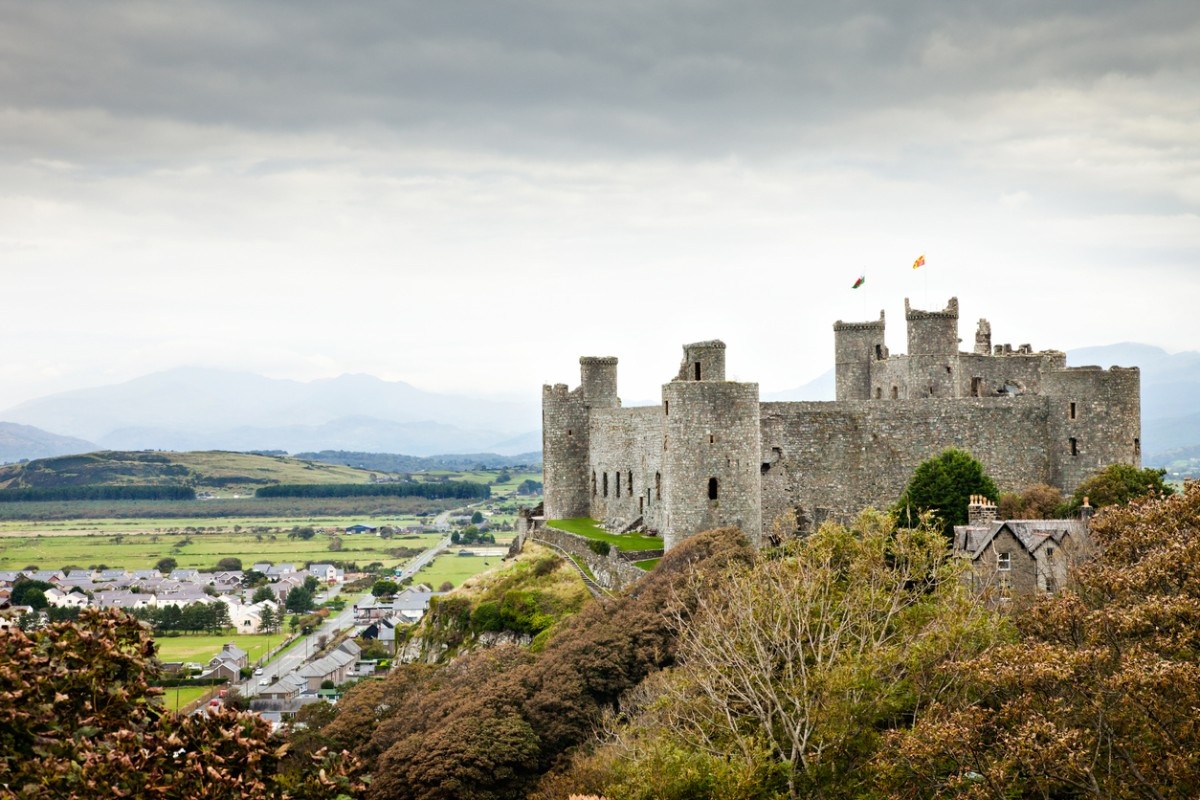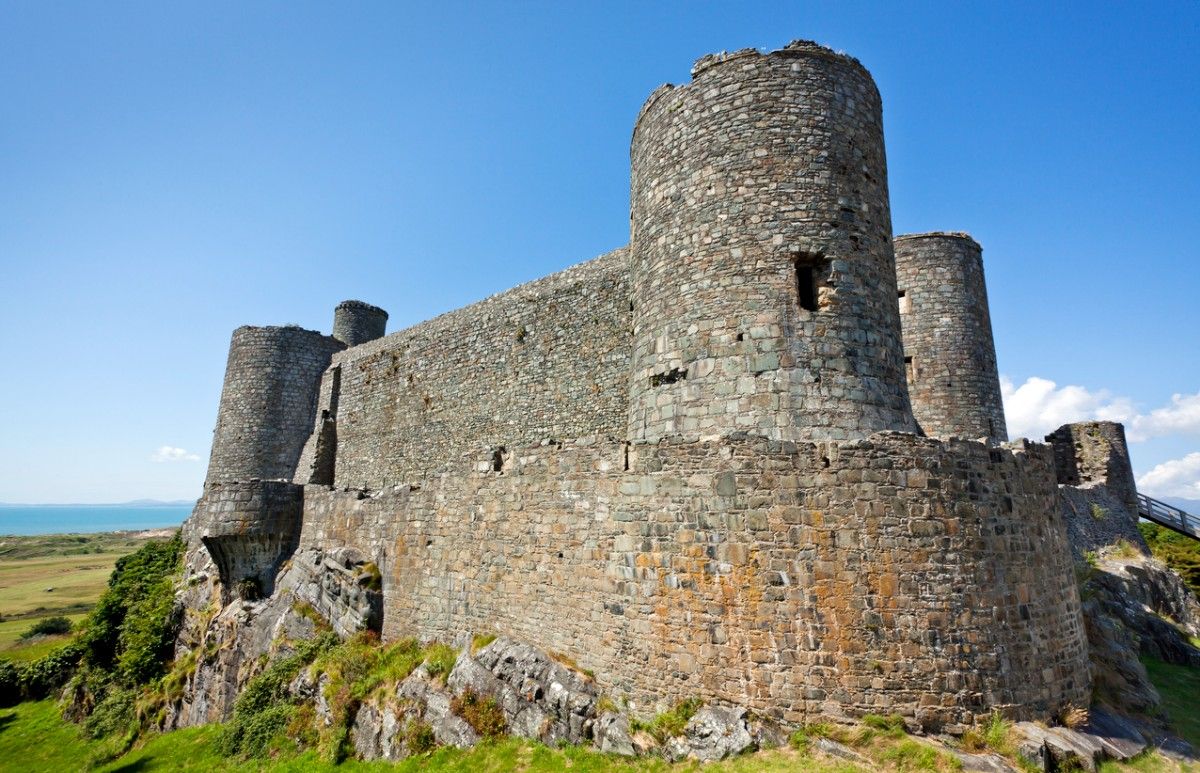Harlech Castle: An Iconic Medieval Fortress in Wales
A Commanding Presence on the Welsh Coastline
Perched atop a rocky crag overlooking the sweeping sands of Cardigan Bay, Harlech Castle stands as a testament to the turbulent history and breathtaking beauty of North Wales. This imposing medieval fortress, built during the reign of Edward I in the late 13th century, has captured the imaginations of visitors for generations. Its strategic location, awe-inspiring architecture, and fascinating past make it a must-visit destination for history enthusiasts, architecture buffs, and anyone seeking to immerse themselves in the rich cultural heritage of Wales.
Harlech Castle's commanding presence is evident from the moment you lay eyes on it. The castle's massive walls and towering gatehouse rise dramatically from the rocky outcrop, seeming to grow organically from the rugged landscape. The castle's design is a masterpiece of medieval military architecture, featuring a concentric layout with two rings of sturdy walls and towers that would have made it virtually impregnable to attackers. The outer wall, with its twin-towered gatehouse and barbican, protected the inner ward, which housed the castle's main living quarters and great hall.
As you approach the castle, it's easy to imagine the sense of awe and intimidation that medieval visitors must have felt. The castle's stunning location and impressive scale are a testament to the power and ambition of its royal builder, as well as the skill and ingenuity of the architects and craftsmen who brought his vision to life. Today, Harlech Castle stands as a proud symbol of Welsh resilience and a reminder of the pivotal role that this small corner of Wales played in the tumultuous history of medieval Britain.
Step Back in Time: Exploring the Castle's Interior
Stepping through the massive gatehouse and into the castle's inner ward is like taking a journey back in time. The castle's well-preserved walls and towers offer a glimpse into the daily life and military realities of medieval Wales, from the grand halls where nobles feasted and conducted business to the cramped guardrooms where soldiers kept watch for signs of trouble.
One of the most impressive features of Harlech Castle's interior is the great hall, located on the south side of the inner ward. This grand space, with its soaring windows and magnificent fireplace, would have been the social and administrative heart of the castle, where the lord and his household gathered for meals, entertainment, and important meetings. Today, visitors can stand in this echoing chamber and imagine the lively scenes of feasting, music, and political intrigue that once took place here.
Another highlight of the castle's interior is the chapel tower, located in the northeast corner of the inner ward. This small but ornate space, with its delicate vaulting and decorative carvings, offers a rare glimpse into the spiritual life of the castle's inhabitants. The chapel tower also offers stunning views over the castle walls and across the bay, making it a popular spot for photographers and anyone who appreciates a breathtaking vista.
As you explore the castle's many towers, passageways, and chambers, you'll gain a newfound appreciation for the complexity and sophistication of medieval castle design. From the cleverly designed arrow loops that allowed archers to defend the walls to the intricate drainage systems that kept the castle dry and habitable, every detail of Harlech Castle's construction speaks to the ingenuity and skill of its builders.
Planning Your Visit to Harlech Castle
Opening Times and Admission Prices
When planning your visit to Harlech Castle, it's important to be aware of the castle's opening times and admission prices. The castle is open year-round, but the exact hours vary depending on the season. From April to October, the castle is typically open from 9:30 am to 5:00 pm, with last admission at 4:30 pm. During the winter months (November to March), the castle is usually open from 10:00 am to 4:00 pm, with last admission at 3:30 pm. However, it's always a good idea to check the official Cadw website or contact the castle directly to confirm the most up-to-date opening times, as they may be subject to change.
As for admission prices, Harlech Castle offers a range of ticketing options to suit different budgets and group sizes. As of 2023, adult admission is £7.30, while children (aged 5-17) and seniors (aged 65+) pay £5.10. Children under 5 can enter for free. Family tickets, which include admission for 2 adults and up to 3 children, are also available for £21.90. If you're planning to visit multiple Cadw sites during your time in Wales, you may want to consider purchasing a Cadw Explorer Pass, which offers unlimited access to over 100 historic sites for either 3 or 7 days.
It's worth noting that Harlech Castle can get quite busy during peak tourist season, especially on weekends and bank holidays. To avoid crowds and ensure a more relaxed visit, consider arriving early in the day or visiting during the shoulder season (spring or fall). You may also want to allow plenty of time for your visit, as there is much to see and explore within the castle walls.
Getting There: Transportation and Parking
Harlech Castle is located in the heart of the charming coastal town of Harlech, in Gwynedd, North Wales. The town is easily accessible by both car and public transportation, making it a convenient destination for visitors from all over the UK and beyond.
If you're driving to Harlech Castle, you'll be pleased to know that there is a large pay-and-display car park located just a short walk from the castle entrance. The car park is operated by the local council and charges apply throughout the year, so be sure to bring some change or a credit card. Alternatively, there is limited free parking available along the streets near the castle, but these spots can fill up quickly during peak times.
For those traveling by public transportation, Harlech is well-served by both bus and rail. The town's railway station is located on the Cambrian Coast line, which runs between Machynlleth and Pwllheli. There are regular services to Harlech from major cities such as Birmingham, Shrewsbury, and Aberystwyth, with journey times ranging from 2-4 hours depending on your starting point. From the railway station, it's just a short walk (around 10-15 minutes) uphill to the castle.
If you're traveling by bus, there are several regular services that stop in Harlech, including the T3 TrawsCymru service, which connects the town with Barmouth, Dolgellau, and Wrexham. The bus stop is located just a few minutes' walk from the castle entrance, making it a convenient option for those without a car.
Accessibility and Facilities
Harlech Castle is committed to making the site as accessible as possible to visitors of all abilities. However, due to the castle's hilltop location and historic architecture, some areas may be challenging for those with mobility issues.
To help visitors with limited mobility, Cadw has installed a lift in the castle's visitor centre, which provides access to the main level of the castle. The lift is located just inside the visitor centre entrance and can accommodate wheelchairs and mobility scooters. Once inside the castle, most areas are accessible, although some paths and staircases may be uneven or steep.
In addition to the lift, Harlech Castle offers a range of facilities to make your visit more comfortable and enjoyable. These include:
- A visitor centre with ticket sales, information desk, gift shop, and restrooms
- Accessible restrooms located in the visitor centre and outer ward
- Benches and seating areas throughout the castle grounds
- Picnic areas in the outer ward and on the castle grounds
- Audio guides (available for rent) that provide a guided tour of the castle in multiple languages
- A large pay-and-display car park with designated spaces for disabled visitors
Visitors with disabilities are entitled to a 50% discount on admission, and caregivers can enter for free. Assistance dogs are welcome in all areas of the castle, including the visitor centre.
If you have any specific accessibility needs or concerns, it's always a good idea to contact the castle directly before your visit. The friendly staff will be happy to answer any questions and provide advice to help you make the most of your time at this magnificent historic site.
History and Architecture of Harlech Castle
The Beginnings: Edward I and the Iron Ring of Castles
The story of Harlech Castle begins in the late 13th century, during the reign of Edward I, one of England's most formidable medieval monarchs. Following his successful campaign to conquer Wales and suppress the rebellious Welsh princes, Edward embarked on an ambitious project to secure his new territories and solidify his rule. This project involved the construction of a string of strategically placed castles, known as the "Iron Ring," which stretched across the north and west of Wales.
Harlech Castle was one of the most important links in this chain of fortifications. Construction began in 1283, under the supervision of Master James of St. George, a renowned architect and military engineer who had previously worked on several of Edward's other Welsh castles. The site chosen for the castle was a rocky outcrop overlooking the Irish Sea, which provided a natural defence and a commanding view of the surrounding landscape.
The castle's design was a masterpiece of medieval military architecture, featuring a concentric layout with two rings of massive stone walls and towers. The outer ward, with its twin-towered gatehouse and barbican, served as the castle's first line of defence, while the inner ward housed the main living quarters, great hall, and other essential buildings. The castle's walls were built using local stone, quarried from the nearby cliffs, and were designed to withstand both siege weapons and the harsh coastal weather.
Architectural Features and Innovations
One of the most striking features of Harlech Castle's architecture is its sheer scale and complexity. The castle's walls and towers are among the tallest and most imposing of any medieval fortress in Britain, rising to heights of over 100 feet in places. The inner ward alone covers an area of over 4 acres, making it one of the largest castle courtyards in Europe.
Despite its size, however, Harlech Castle is also notable for its intricate design and attention to detail. The castle's walls and towers are punctuated by numerous arrow loops, murder holes, and other defensive features, each carefully placed to provide maximum coverage and protection. The great hall, located on the south side of the inner ward, is a particularly impressive example of medieval craftsmanship, with its soaring windows, magnificent fireplace, and ornate wooden roof.
Another notable feature of Harlech Castle's architecture is its innovative use of water. The castle was designed to be self-sufficient in the event of a prolonged siege, with its own deep well and sophisticated drainage system. The well, which was sunk over 200 feet into the bedrock beneath the castle, provided a reliable source of fresh water for the garrison, while the drainage system helped to keep the castle dry and habitable even in the wettest weather.
Perhaps the most impressive feat of engineering at Harlech Castle, however, was the massive stairway that once connected the castle to the sea. Known as the "Way from the Sea," this stairway was cut into the sheer cliff face below the castle and provided a vital lifeline for the garrison during times of siege. Although the stairway has long since vanished, visitors to Harlech Castle can still see the remnants of the "Way from the Sea" and marvel at the ingenuity and determination of the castle's builders.
The Many Sieges and Battles of Harlech Castle
The Welsh Rebellions and the Fall of Llywelyn
Although Harlech Castle was built as a symbol of English power and authority in Wales, it quickly became a focal point for Welsh resistance and rebellion. In the years following the castle's construction, the Welsh people, led by the charismatic prince Llywelyn ap Gruffudd, launched a series of uprisings against English rule, seeking to reclaim their ancestral lands and restore their independence.
One of the most significant of these rebellions occurred in 1294, just a decade after Harlech Castle was completed. The uprising, known as the Madog Rebellion, was a widespread and well-organised campaign that caught the English by surprise and threatened to undo all of Edward I's hard-won gains in Wales. Harlech Castle, with its strategic location and formidable defences, became a key stronghold for the English during this time, withstanding several sieges and attacks by Welsh forces.
Despite the best efforts of the Welsh rebels, however, the Madog Rebellion was ultimately crushed by Edward I's armies, and Llywelyn ap Gruffudd was killed in battle in 1282. With the death of their leader and the fall of their last remaining strongholds, the Welsh resistance was effectively broken, and Harlech Castle became a symbol of English dominance and control.
The Glyndŵr Rising and the "Men of Harlech"
The next major conflict to engulf Harlech Castle occurred over a century later, during the reign of Henry IV. In 1400, a Welsh nobleman named Owain Glyndŵr launched a rebellion against English rule, seeking to establish an independent Welsh state and restore the ancient rights and privileges of the Welsh people.
Glyndŵr's rebellion, known as the Glyndŵr Rising, was a long and bloody conflict that raged across Wales for over a decade. Harlech Castle, once again, found itself at the centre of the storm, as Glyndŵr's forces laid siege to the castle in 1404. The siege lasted for several months, with the castle's garrison holding out against repeated attacks and bombardments.
In a daring raid, Glyndŵr's men managed to capture the castle in 1409, but their victory was short-lived. English forces quickly regrouped and launched a counterattack, retaking the castle and driving Glyndŵr's army back into the mountains. The story of the siege and the bravery of the castle's defenders has been immortalised in the famous Welsh song "Men of Harlech," which has become an enduring symbol of Welsh pride and resilience.
The War of the Roses and the Seven-Year Siege
The final and perhaps most famous siege of Harlech Castle occurred during the Wars of the Roses, a series of dynastic conflicts that engulfed England and Wales in the 15th century. In 1461, the castle was held by Lancastrian forces loyal to King Henry VI, who were besieged by the Yorkist army of Edward IV.
The siege that followed was one of the longest and most gruelling in British history, lasting for a staggering seven years. The castle's defenders, led by the indomitable Constable Dafydd ap Ieuan, held out against incredible odds, enduring starvation, disease, and constant bombardment from the Yorkist cannons.
Despite their heroic efforts, however, the defenders of Harlech Castle were eventually forced to surrender in 1468, after a negotiated truce. The Yorkists took control of the castle, and it remained in their hands for the remainder of the Wars of the Roses.
The story of the seven-year siege has become an enduring legend in Welsh history, a testament to the bravery and resilience of the Welsh people in the face of overwhelming adversity. Today, visitors to Harlech Castle can still see the scars of this epic battle, etched into the castle's walls and towers, and marvel at the incredible endurance and determination of its defenders.
Exploring the Surrounding Area: Harlech Town and Snowdonia National Park
Harlech Town: A Hidden Gem on the Welsh Coast
While Harlech Castle is undoubtedly the main attraction that draws visitors to this corner of North Wales, the charming town of Harlech itself is well worth exploring. Nestled between the mountains and the sea, Harlech is a hidden gem that offers a perfect blend of natural beauty, historic charm, and local culture.
At the heart of Harlech is its picturesque high street, lined with colourful houses, independent shops, and cosy cafes. Visitors can spend a pleasant afternoon browsing the local boutiques, sampling traditional Welsh delicacies, or simply soaking up the friendly atmosphere of this welcoming community.
One of the most popular spots in Harlech is the famous Castle Cottage Restaurant, which has been serving up delicious home-cooked meals for over 50 years. Located just a stone's throw from the castle, this cosy eatery is the perfect place to refuel after a day of exploring, with a menu that features hearty Welsh classics like cawl (lamb and vegetable soup), Welsh rarebit, and bara brith (fruit loaf).
Another must-see attraction in Harlech is the town's stunning sandy beach, which stretches for miles along the coast of Cardigan Bay. The beach is easily accessible from the town centre and offers a range of activities for visitors of all ages, from swimming and sunbathing to rock pooling and beachcombing. On a clear day, the views from the beach are truly breathtaking, with the distant peaks of Snowdonia rising up from the horizon.
For those interested in the town's history and culture, Harlech also boasts a number of fascinating museums and heritage sites. The Royal Saint David's Golf Club, founded in 1894, is one of the oldest and most prestigious golf courses in Wales, with a challenging links layout that offers stunning views of the castle and the sea. The town is also home to the Harlech Pottery Studio, where visitors can watch local artisans at work and purchase unique handcrafted ceramics.
Snowdonia National Park: A Natural Wonder on Harlech's Doorstep
Just a short drive from Harlech lies one of the UK's most spectacular natural wonders: Snowdonia National Park. Covering over 800 square miles of rugged mountain scenery, crystal-clear lakes, and lush green valleys, Snowdonia is a paradise for outdoor enthusiasts and nature lovers.
One of the most popular ways to experience Snowdonia is by taking a ride on the Snowdon Mountain Railway, which has been ferrying visitors to the summit of Wales' highest peak since 1896. The railway offers a comfortable and scenic way to reach the top of Snowdon, with breathtaking views of the surrounding landscape at every turn.
For those who prefer a more active approach, Snowdonia is crisscrossed by a network of hiking trails that range from gentle riverside strolls to challenging mountain ascents. One of the most iconic hikes in the park is the Watkin Path, which starts just a few miles from Harlech and offers a stunning route up the southern flank of Snowdon.
Other popular activities in Snowdonia include rock climbing, mountain biking, and wild swimming in the park's many lakes and rivers. For a more relaxing day out, visitors can explore the charming villages and towns that dot the park, such as Betws-y-Coed, Beddgelert, and Dolgellau, each with its own unique character and history.
No matter how you choose to experience Snowdonia, one thing is for sure: this incredible landscape will leave a lasting impression on all who visit. With its rugged beauty, rich wildlife, and endless opportunities for adventure, Snowdonia is the perfect complement to a visit to Harlech Castle, offering a chance to discover the wild heart of Wales.
Cultural Significance and Legacy of Harlech Castle
A Symbol of Welsh Pride and Resilience
Harlech Castle is much more than just a historic landmark or tourist attraction; it is a powerful symbol of Welsh identity, pride, and resilience. For centuries, the castle has stood as a testament to the bravery and determination of the Welsh people, who have fought tirelessly to preserve their language, culture, and way of life in the face of overwhelming odds.
One of the most enduring expressions of this spirit is the famous Welsh song "Men of Harlech," which tells the story of the castle's epic seven-year siege during the Wars of the Roses. The song, with its stirring melody and defiant lyrics, has become an anthem of Welsh national pride, sung at rugby matches, cultural festivals, and other celebrations of Welsh heritage.
Beyond its musical legacy, Harlech Castle has also played a significant role in Welsh literature and art. The castle has been the subject of countless poems, stories, and paintings over the centuries, each seeking to capture its rugged beauty and rich history. One of the most famous literary works associated with the castle is the medieval Welsh tale "The Dream of Macsen Wledig," which tells the story of a Roman emperor who dreams of a beautiful maiden in a faraway castle, believed to be Harlech.
In more recent times, Harlech Castle has become an important symbol of Welsh cultural identity and political aspirations. During the 20th century, the castle was a rallying point for Welsh nationalists and language activists, who saw it as a powerful reminder of Wales' distinct history and heritage. Today, the castle remains a focal point for cultural events and celebrations, from poetry readings and music performances to historical reenactments and art exhibitions.
Preserving the Legacy for Future Generations
As one of Wales' most iconic and significant historic sites, Harlech Castle is a treasured part of the nation's cultural heritage. In recognition of this, the castle is now under the care of Cadw, the Welsh government's historic environment service, which is responsible for preserving and promoting Wales' built heritage.
Under Cadw's stewardship, Harlech Castle has undergone extensive conservation and restoration work in recent years, aimed at preserving the castle for future generations. This work has included repairs to the castle's walls and towers, as well as the creation of new visitor facilities and interpretive exhibits.
One of the most exciting recent developments at Harlech Castle has been the opening of a new visitor centre, which provides a state-of-the-art gateway to the castle and its history. The centre features interactive displays, multimedia exhibits, and a range of educational resources that help bring the castle's story to life for visitors of all ages.
As part of its commitment to accessibility and inclusivity, Cadw has also worked to make Harlech Castle more welcoming to visitors with disabilities, with the installation of lifts, ramps, and other facilities that improve access to the castle's many levels and spaces.
Perhaps most importantly, however, Cadw is working to ensure that Harlech Castle's legacy is preserved not just in stone and mortar, but in the hearts and minds of the Welsh people. Through educational programs, community outreach, and partnerships with local organisations, Cadw is helping to keep the castle's story alive and relevant for new generations, ensuring that its message of pride, resilience, and cultural identity continues to inspire and uplift for centuries to come.
Visiting Harlech Castle with Children: Tips and Activities
Engaging Young Minds: Making History Come Alive
Visiting Harlech Castle with children can be a wonderful opportunity to spark their interest in history and culture, but it can also be challenging to keep them engaged and entertained. Fortunately, with a little creativity and planning, you can turn a trip to the castle into an unforgettable adventure for the whole family.
One of the key things to keep in mind when visiting Harlech Castle with children is to make the experience interactive and hands-on. Rather than simply reciting facts and dates, try to bring the castle's story to life through games, activities, and role-playing.
For younger children, this might mean bringing along costumes and props so they can dress up as knights, princesses, or other medieval characters. Encourage them to explore the castle's many rooms and passages, imagining what life would have been like for the people who lived and worked there centuries ago.
For older children, you can delve deeper into the castle's history and architecture, using scavenger hunts or quiz sheets to encourage them to pay attention to details and ask questions. You can also use the castle as a springboard for discussions about broader topics like warfare, society, and politics in the Middle Ages.
Another great way to engage children at Harlech Castle is through storytelling. The castle has a rich and fascinating history, full of tales of bravery, treachery, and adventure. Before your visit, read up on some of the most exciting stories associated with the castle, such as the epic siege during the Wars of the Roses or the legend of the "Men of Harlech." Then, as you explore the castle together, bring these stories to life by pointing out key locations and features and asking children to imagine themselves in the shoes of the characters involved.
Practical Tips for a Family-Friendly Visit
Of course, engaging young minds is only half the battle when it comes to visiting Harlech Castle with children. To ensure a smooth and stress-free visit, it's important to plan ahead and take some practical steps to make the experience as comfortable and enjoyable as possible.
First and foremost, make sure to check the castle's opening times and admission prices before you visit, to avoid any disappointment or confusion on the day. It's also a good idea to book tickets in advance, especially during peak season, to avoid long queues and crowds.
When packing for your visit, be sure to bring plenty of snacks, drinks, and sun protection, as well as comfortable shoes and clothing suitable for the weather. The castle's grounds can be uneven and steep in places, so it's important to wear sturdy footwear and take breaks as needed.
If you're planning to spend a full day at the castle, consider bringing along a picnic lunch to enjoy in the castle's scenic surroundings. There are plenty of grassy areas and benches where you can spread out a blanket and enjoy a relaxing family meal with a stunning view.
Finally, don't forget to make time for breaks and downtime during your visit. Children (and adults!) can easily become overwhelmed or fatigued by too much information or activity, so be sure to pace yourself and take regular breaks to rest, play, and recharge.
By following these practical tips and focusing on engagement and interaction, visiting Harlech Castle with children can be a truly memorable and enriching experience for the whole family. Whether you're sparking a lifelong interest in history or simply enjoying a fun day out together, the castle offers endless opportunities for learning, discovery, and adventure.
Harlech Castle's Place in Welsh Nationalism and Identity
A Bastion of Welsh Resistance and Pride
For centuries, Harlech Castle has stood as a powerful symbol of Welsh resistance and pride in the face of English domination. From the time of its construction in the late 13th century, the castle has been at the centre of some of the most pivotal moments in Welsh history, serving as a bastion of defiance against foreign rule and a rallying point for Welsh national identity.
One of the most famous examples of this is the castle's role in the Glyndŵr Rising of the early 15th century. During this time, the castle was held by Welsh forces loyal to Owain Glyndŵr, the last native Prince of Wales, who led a powerful rebellion against English rule. For years, the castle withstood repeated sieges and attacks by English armies, becoming a symbol of Welsh resistance and determination.
Even after the eventual defeat of the Glyndŵr Rising, Harlech Castle continued to hold a special place in the hearts and minds of the Welsh people. The castle's legendary seven-year siege during the Wars of the Roses, when a small band of Welsh defenders held out against overwhelming English forces, further cemented its status as a symbol of Welsh courage and resilience.
In the centuries that followed, Harlech Castle remained a powerful icon of Welsh national identity, even as Wales itself was gradually absorbed into the larger British state. The castle's image appeared on everything from postcards and posters to political pamphlets and propaganda, serving as a potent reminder of Wales' distinct history and heritage.
A Symbol of Welsh Cultural Revival
In the late 19th and early 20th centuries, Harlech Castle took on new significance as a symbol of the Welsh cultural revival. During this period, Wales underwent a remarkable renaissance in literature, music, and the arts, as a new generation of writers, composers, and artists sought to celebrate and promote Welsh language and culture.
One of the key figures in this movement was the Welsh composer Edward T. Davies, who wrote the famous song "Men of Harlech" in 1873. The song, which tells the story of the castle's epic siege during the Wars of the Roses, quickly became an anthem of Welsh national pride, sung at rugby matches, cultural festivals, and other celebrations of Welsh heritage.
In the decades that followed, Harlech Castle became a frequent subject of Welsh art and literature, from the paintings of Richard Wilson and J.M.W. Turner to the poetry of R.S. Thomas and Gillian Clarke. The castle's rugged beauty and rich history made it a natural source of inspiration for artists seeking to capture the essence of Welsh identity and experience.
Today, Harlech Castle remains a powerful symbol of Welsh cultural pride and resilience, drawing visitors from around the world who are eager to learn about Wales' unique history and heritage. The castle's museums and exhibitions offer a fascinating glimpse into the lives and struggles of the Welsh people over the centuries, from the time of the native princes to the modern era.
But perhaps the castle's greatest legacy is the way it continues to inspire and uplift the Welsh people themselves. Whether it's through the stirring lyrics of "Men of Harlech," the timeless beauty of Welsh art and literature, or simply the quiet pride that comes from standing on the battlements and surveying the surrounding landscape, Harlech Castle remains a vital part of the Welsh national psyche, a testament to the enduring spirit and resilience of this small but mighty nation.
Accessibility and Facilities at Harlech Castle
Making History Accessible to All
Harlech Castle is one of Wales' most iconic and beloved historic sites, drawing visitors from around the world who are eager to explore its rich history and stunning architecture. However, for many visitors with disabilities or mobility issues, accessing the castle's many levels and spaces can be a challenge.
In recent years, Cadw, the Welsh government's historic environment service, has made significant efforts to improve accessibility at Harlech Castle and other historic sites across Wales. These efforts have included the installation of lifts, ramps, and other facilities designed to make the castle more welcoming and inclusive to visitors of all abilities.
One of the most significant improvements at Harlech Castle has been the installation of a new lift in the visitor centre, which provides step-free access to the main level of the castle. The lift is spacious enough to accommodate wheelchairs and mobility scooters, and is operated by trained staff who are on hand to assist visitors as needed.
Once inside the castle, visitors will find that many areas are now accessible via ramps and level walkways, including the inner ward, the great hall, and the chapel tower. These improvements have made it possible for visitors with mobility issues to experience the castle's most spectacular spaces and features, from the soaring windows of the great hall to the stunning views from the chapel tower.
Of course, given the castle's age and design, some areas may still be challenging for visitors with disabilities. The castle's steep, narrow staircases and uneven surfaces can be difficult to navigate, even with the aid of handrails and other supports. However, Cadw has worked to provide clear signage and information about accessibility throughout the site, so visitors can make informed decisions about which areas to explore and which to avoid.
In addition to physical accessibility, Harlech Castle has also made efforts to improve the visitor experience for those with sensory or cognitive disabilities. The castle's audio guides, for example, are available in multiple languages and include a British Sign Language version for deaf or hard-of-hearing visitors. The castle's exhibits and displays also include tactile elements and large-print text to make them more accessible to visitors with visual impairments.
Modern Facilities in a Medieval Setting
Of course, accessibility is just one aspect of the visitor experience at Harlech Castle. To make the site as welcoming and enjoyable as possible for all visitors, Cadw has also invested in a range of modern facilities and amenities that blend seamlessly with the castle's medieval architecture.
One of the most notable of these facilities is the castle's new visitor centre, which opened in 2015. The centre includes a spacious reception area, a well-stocked gift shop, and a café with stunning views of the castle and the surrounding landscape. The centre also houses a range of interactive exhibits and displays that provide visitors with a fascinating introduction to the castle's history and significance.
Another key facility at Harlech Castle is the site's network of accessible restrooms, which are located throughout the castle grounds. These restrooms are modern, clean, and well-maintained, with plenty of space for wheelchairs and other mobility aids. The castle also has a dedicated changing places facility, which provides a safe and private space for visitors with complex care needs.
For families visiting Harlech Castle, the site also offers a range of amenities designed to make the experience as enjoyable and stress-free as possible. The castle's picnic areas and benches provide plenty of space for families to relax and refuel, while the site's family-friendly activities, such as the castle trail and the dressing-up box, help to keep children engaged and entertained.
Finally, for dog owners planning a trip to Harlech Castle, the site is proud to be a dog-friendly attraction. Well-behaved dogs on leads are welcome in all areas of the castle, including the visitor centre and the grounds. The castle even provides water bowls and waste bins to help make the experience as comfortable as possible for four-legged visitors.
Overall, the combination of modern facilities and accessibility improvements at Harlech Castle has helped to create a truly inclusive and welcoming visitor experience. Whether you're a history buff, a family on a day out, or a visitor with disabilities, the castle offers a range of amenities and supports to ensure that everyone can enjoy this remarkable site to the fullest.
Related Articles

Let us know you agree to cookies
We use marketing, analytical and functional cookies as well as similar technologies to give you the best experience. Third parties, including social media platforms, often place tracking cookies on our site to show you personalised adverts outside of our website.
We store your cookie preferences for two years and you can edit your preferences via ‘manage cookies’ or through the cookie policy at the bottom of every page. For more information, please see our cookie policy.
